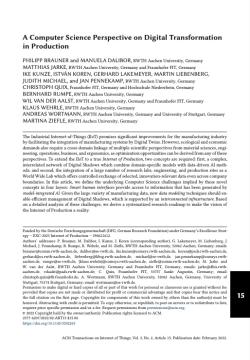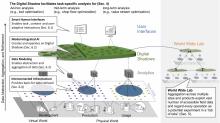
Abstract
The Industrial Internet-of-Things (IIoT) promises significant improvements for the manufacturing industry by facilitating the integration of manufacturing systems by Digital Twins. However, ecological and economic demands also require a cross-domain linkage of multiple scientific perspectives from material sciences, engineering, operations, business, and ergonomics, as optimization opportunities can be derived from any of these perspectives. To extend the IIoT to a true Internet of Production , two concepts are required: first, a complex, interrelated network of Digital Shadows which combine domain-specific models with data-driven AI methods; and second, the integration of a large number of research labs, engineering, and production sites as a World Wide Lab which offers controlled exchange of selected, innovation-relevant data even across company boundaries. In this article, we define the underlying Computer Science challenges implied by these novel concepts in four layers: Smart human interfaces provide access to information that has been generated by model-integrated AI . Given the large variety of manufacturing data, new data modeling techniques should enable efficient management of Digital Shadows, which is supported by an interconnected infrastructure . Based on a detailed analysis of these challenges, we derive a systematized research roadmap to make the vision of the Internet of Production a reality.
The Industrial Internet-of-Things (IIoT) promises significant improvements for the manufacturing industry by facilitating the integration of manufacturing systems by Digital Twins. However, ecological and economic demands also require a cross-domain linkage of multiple scientific perspectives from material sciences, engineering, operations, business, and ergonomics, as optimization opportunities can be derived from any of these perspectives. To extend the IIoT to a true Internet of Production , two concepts are required: first, a complex, interrelated network of Digital Shadows which combine domain-specific models with data-driven AI methods; and second, the integration of a large number of research labs, engineering, and production sites as a World Wide Lab which offers controlled exchange of selected, innovation-relevant data even across company boundaries. In this article, we define the underlying Computer Science challenges implied by these novel concepts in four layers: Smart human interfaces provide access to information that has been generated by model-integrated AI . Given the large variety of manufacturing data, new data modeling techniques should enable efficient management of Digital Shadows, which is supported by an interconnected infrastructure . Based on a detailed analysis of these challenges, we derive a systematized research roadmap to make the vision of the Internet of Production a reality.
Related Project(s):
